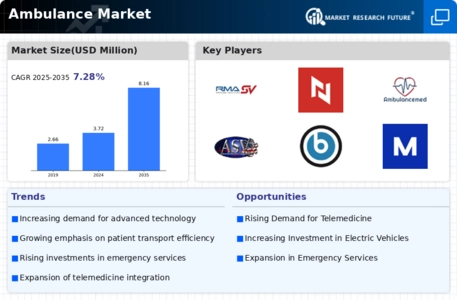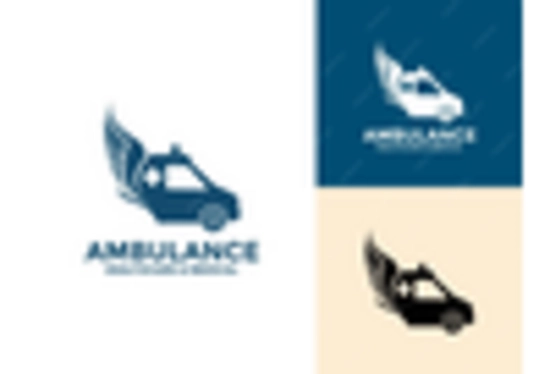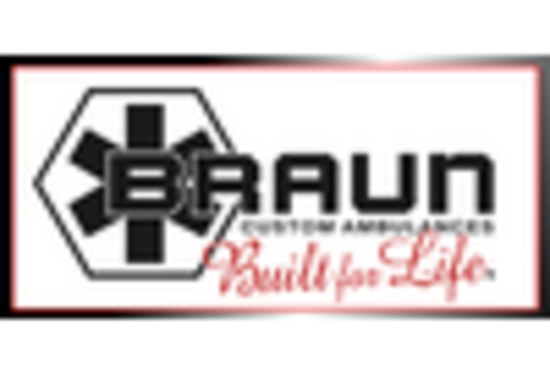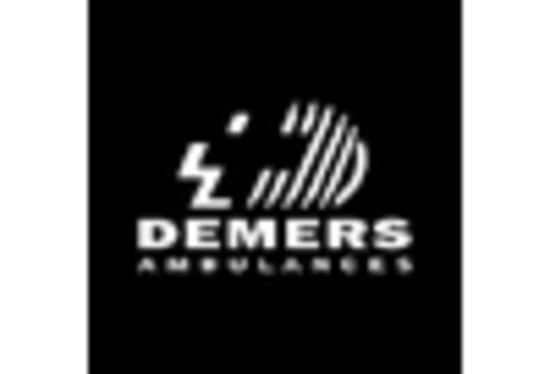Government Initiatives and Funding
Government initiatives and funding play a crucial role in shaping the Ambulance Market. Many governments are recognizing the importance of efficient emergency medical services and are allocating resources to enhance ambulance services. This includes funding for new ambulance purchases, training programs for paramedics, and the development of advanced emergency response systems. For example, recent government budgets have earmarked substantial amounts for improving healthcare infrastructure, which directly impacts the ambulance sector. Such initiatives not only bolster the capabilities of existing services but also encourage private sector participation, leading to a more robust Ambulance Market. The ongoing support from governmental bodies is likely to sustain growth in this sector.
Rising Awareness of Health and Safety
The increasing awareness of health and safety among the public is significantly influencing the Ambulance Market. As individuals become more conscious of the importance of immediate medical assistance, there is a growing expectation for accessible and efficient ambulance services. This heightened awareness is reflected in community initiatives that promote emergency preparedness and first aid training, which in turn drives demand for ambulances. Moreover, organizations are increasingly investing in health and safety protocols, necessitating the availability of ambulances for workplace emergencies. Consequently, the Ambulance Market is likely to experience growth as stakeholders respond to this societal shift, ensuring that emergency services are readily available and equipped to handle various situations.
Expansion of Private Ambulance Services
The expansion of private ambulance services is a notable trend within the Ambulance Market. As healthcare systems evolve, private entities are increasingly entering the market, offering specialized services that cater to diverse patient needs. This includes non-emergency medical transportation, which has gained traction as patients seek more flexible options for accessing healthcare. The presence of private ambulance services not only enhances competition but also drives innovation in service delivery. Furthermore, the collaboration between public and private sectors is becoming more common, leading to improved service integration. This trend suggests that the Ambulance Market will continue to diversify, providing a wider array of options for consumers and potentially improving overall healthcare outcomes.
Increasing Demand for Emergency Medical Services
The rising demand for emergency medical services is a pivotal driver in the Ambulance Market. As populations grow and urban areas expand, the need for timely medical assistance becomes more pronounced. According to recent statistics, the number of emergency calls has surged, necessitating an increase in ambulance availability. This trend is further fueled by an aging population, which typically requires more frequent medical attention. Consequently, healthcare providers are compelled to enhance their ambulance fleets to meet this escalating demand. The Ambulance Market is thus witnessing a shift towards more efficient and responsive emergency services, ensuring that patients receive timely care. This demand is likely to continue growing, prompting investments in both traditional and advanced ambulance services.
Technological Advancements in Ambulance Services
Technological advancements are reshaping the Ambulance Market, introducing innovative solutions that enhance operational efficiency and patient care. The integration of telemedicine, real-time data analytics, and GPS tracking systems has revolutionized how ambulances operate. For instance, the use of telemedicine allows paramedics to consult with doctors en route, ensuring that patients receive appropriate care before reaching the hospital. Furthermore, data analytics can optimize route planning, reducing response times significantly. As these technologies become more prevalent, they are likely to drive the growth of the Ambulance Market, as stakeholders seek to adopt cutting-edge solutions to improve service delivery and patient outcomes.

















Leave a Comment